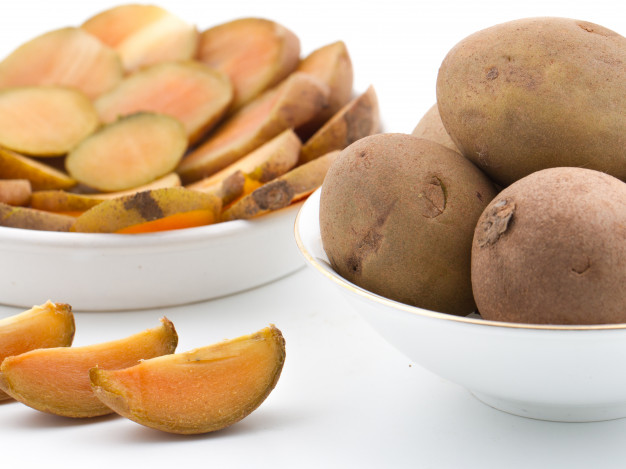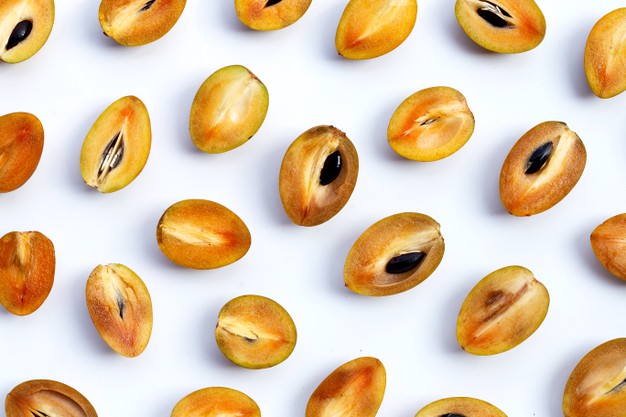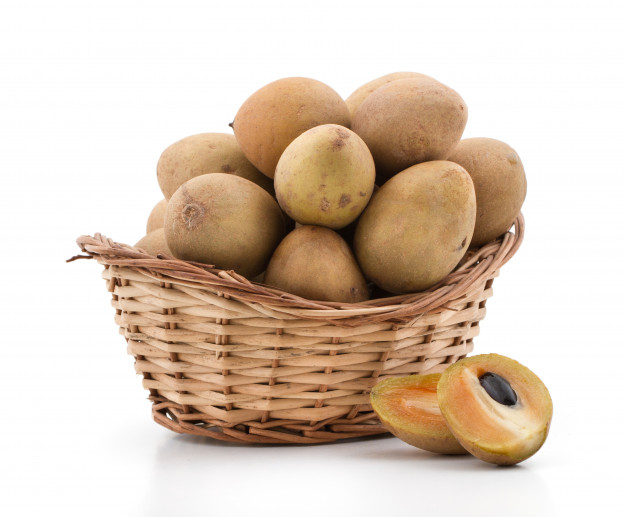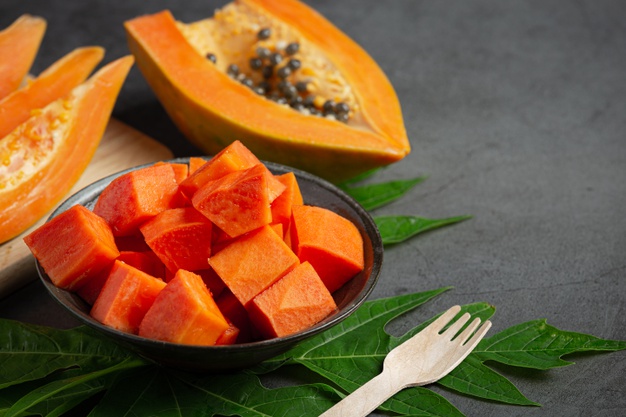Sapota is a nutrient dense delicious fruit belongs to Sapotaceae family. It is native to Central America, Mexico and Caribbean island. It has been extensively used for various medicinal purposes.
Nutritional composition
- It contains desirable amount of carbohydrates and especially it is rich in glucose, fructose and sucrose
- It contains adequate amount of dietary fibre as well
- It contains lesser amount of proteins and fats
- It is packed with numerous essential micronutrients, which include, Vitamin A, E, K, C, B1, B2, B3, B5, B6, B9, sodium, potassium, calcium, phosphorus, iron, copper, zinc, selenium and magnesium
- It contains several phenolic compounds as well that exert various nutraceutical activities

Biological activity
Antioxidant activity
- It is loaded with various imperative micronutrients that act as antioxidant and help to protect the body from the harmful effect of free radicals and reactive oxygen species
- Its consumption is also very beneficial for decreasing the risk of developing chronic diseases as it helps to prevent oxidative stress within body
- It helps to improve cellular functionality as well thus promotes well being
Anti-carcinogenic activity

- As it is associated with reducing oxidative stress thus its consumption is thought to be extremely effective for decreasing the prevalence of carcinoma, as oxidative stress is considered as one of the most leading causes of cancers
- Vitamin A and B Vitamins components of sapota are responsible for maintaining the healthy mucus lining, which ultimately helps to lessen the prevalence of oral cancer and lung cancer
- Its fibre content is also accountable for decreasing the risk of developing colon cancer, as it is related with increasing colonic motility or peristalsis
Anti-inflammatory activity
- Its phytonutrient components especially tannin exerts strong anti-inflammatory activity that help to prevent inflammation by decreasing the concentration of inflammatory mediators in body
- It also helps in preventing swelling and pain
Health benefits
Role on immunity
- Its Vitamin A, Vitamin C and polyphenolic components are accountable for strengthening the immune system, which ultimately helps to increase the resistance power of the body thus its consumption is thought to be very effective for decreasing the susceptibility of becoming ill
- Its antioxidant activity also helps to maintain the structural integrity and the activity of immune cells by protecting them from free radical induced oxidative damages
- It helps to shield the body from microbial attack as well, thus helps to decrease the prevalence of infectious diseases
- It is also very effective for preventing normal cold and flu

Role in digestive health
- It contains various imperative nutrients that help to improve digestive health
- Tannin is a natural plant compound present in sapota plays important role in neutralizing acid secretion within intestine
- Its antibacterial activity and anti-parasitic activity help in soothing the digestive tract thus helps to prevent irritable bowel syndrome and gastritis
- Its fibre content plays imperative role in preventing constipation by enhancing bowel movement, stool bulkiness as well as stool softness and leading to easy defecation
- Its fibre content is also accountable for improving colonic health as it stimulates peristalsis (mentioned above) and it also promotes gut health by enhancing the growth of intestinal beneficial microbes
Role on skeletal system
- It contains significant amount of calcium and phosphorus, both of the minerals are essentially required by the body for healthy bone formation. Apart from its calcium and phosphorus components, it has seen that sapota contains another two important micronutrients that also play vital role in improving bone quality, which include copper and iron thus it is better to include sapota in diet for maintain a healthy skeletal system
- It is closely related with increasing bone mineral density, which plays imperative role in improving bone mass as well as strength thus reduces the prevalence of bone disorders

Role on skin
- Vitamin A, C, E, and K found in sapota play vital role in rejuvenating skin cells
- It also helps to keep the skin hydrated
- Its polyphenolic components are accountable for protecting the skin from oxidative damages hence prevent ageing
- It helps to improve complexion too
- It also helps in improving skin elasticity
- It has seen that milky sap derived from sapota has been extensively used for clearing warts and fungal infections from skin

Role on vision
- It contains significant amount of Vitamin A thus its consumption is believed to be extremely beneficial for promoting eye health
- Its consumption is associated with improving the health of cornea, which promotes vision
Role on maternal health
- Its micronutrient, macronutrient and phytonutrient components make it an important therapeutic substance of gestational period as it helps to provide several vital nutrients, which are essentially required for the proper nourishment of mother and fetus both
- As it is rich in electrolytes especially potassium thus it helps a pregnant women to manage morning sickness as well as dizziness
- Vitamin C present in sapota helps in collagen synthesis, which plays imperative role in reducing the prevalence of stomach related disorders during pregnancy
- Its iron and folic acid contents also play crucial role in pregnancy as they help to reduce the risk of anemia and birth defects

Role on metabolism
- Consumption of sapota helps to boost the energy level of the body
- Sucrose and fructose components of sapota are considered as the main components that are responsible for providing energy quickly
Therapeutic uses
It is widely used for various medicinal purposes, which include –
- It helps to reduce high blood pressure. Its potassium content is responsible for preventing hypertension as it is associated with improving blood circulation and it helps to lower sodium level as well that also plays significant role in maintaining normal blood pressure
- Its B vitamin components especially Vitamin B6 plays important role in improving brain health and functionality thus its consumption is thought to be extremely helpful for lessening the prevalence of neurological disorders
- It helps to relax muscle and also provides calmness to the body, which ultimately helps to reduce stress level and anxiety. It also promotes healthy sleeping
- Being a good source of iron it is widely used as an imperative preventive measure for iron deficiency anemia
 It helps to improve the symptoms of arthritis as well
It helps to improve the symptoms of arthritis as well
Ayurvedic uses
- It has been traditionally used in Ayurveda for treating various maladies
- It is mainly used for treating skin disorders
- Sapota seed oil is also used for preparing skin ointments and creams
- It is used for treating dandruff and several scalp related issues as well
Culinary uses
- It can be consumed alone
- It can be used for preparing halwa or barfi or kheer
- It can also be added with fruit salad
- It can be used for preparing milk shake or smoothies
- It can also be used for preparing jam, jellies, cakes, ice cream and other desserts
General consideration of using sapota
It is better to wash the fruit properly before consumption. It should be cut into halves and seeds should be discarded.
Risk factors
As it contains tannin and latex thus excessive consumption of sapota especially unripe sapota may develop itchy sensation in throat or mouth or often it may cause breathing difficulty too thus it is better to consume sapota when it turns soft and should also be consumed moderately.


Source:
Baskar, M., Hemalatha, G. and Muneeshwari, P., 2020. Traditional and Medicinal Importance of Sapota–Review. Int. J. Curr. Microbiol. App. Sci, 9(1), pp.1711-1717.
Kaur, J., Singh, A., Singh, B. and Sharma, S., 2020. Sapota. In Antioxidants in Fruits: Properties and Health Benefits (pp. 181-199). Springer, Singapore.
Kulkarni, A.P., Policegoudra, R.S. and Aradhya, S.M., 2007. Chemical composition and antioxidant activity of sapota (Achras sapota Linn.) fruit. Journal of food biochemistry, 31(3), pp.399-414.
Menezes, J. and Athmaselvi, K.A., 2016. Polysaccharide based edible coating on sapota fruit. International Agrophysics, 30(4).
Padmavathi, D., A study on nutritional and health importance of “Sapotas”.
Thakore, S.I., Nagar, P.S., Jadeja, R.N., Thounaojam, M., Devkar, R.V. and Rathore, P.S., 2019. Sapota fruit latex mediated synthesis of Ag, Cu mono and bimetallic nanoparticles and their in vitro toxicity studies. Arabian Journal of Chemistry, 12(5), pp.694-700.









